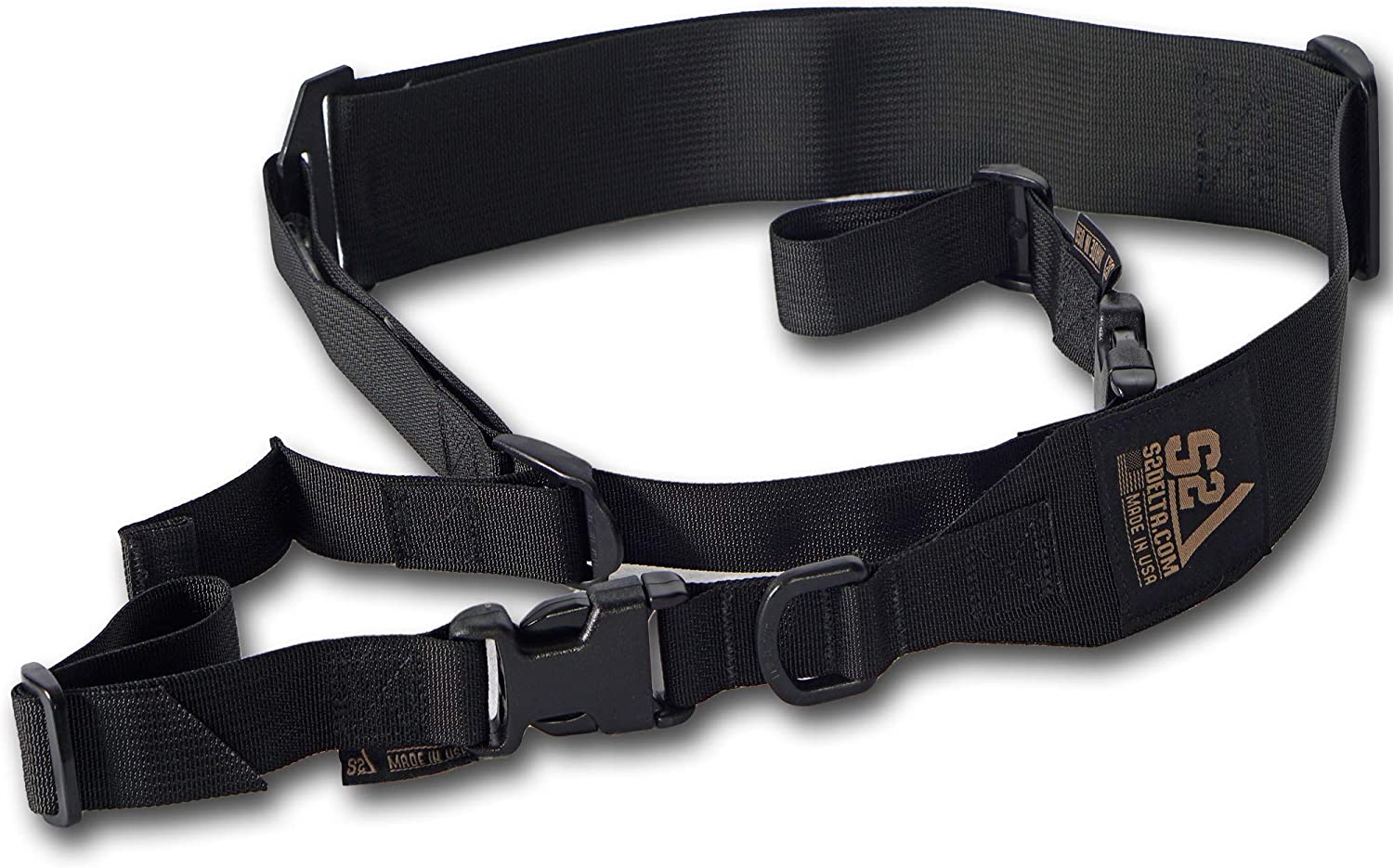The Ultimate AR-15 Sling Guide + Top Picks [2023]
Posted by 80-Lower.com on Jul 20th 2021
A sling makes carrying your AR-15 easier. It allows for quickly switching from your rifle to a sidearm, too. But most of all, a good sling is a valuable shooting aid. It improves accuracy and stability without a bench or shooting rest. With the right sling, you'll nail shot placement and reduce felt recoil and muzzle rise. This guide breaks down the AR's sling mounts, materials, features to consider, types of slings, and how to use one while carrying and shooting. This writer's recommendations are based on range time and backwoods stints, and eight years humping around various rifles in uniform.
Types of Sling Mounts
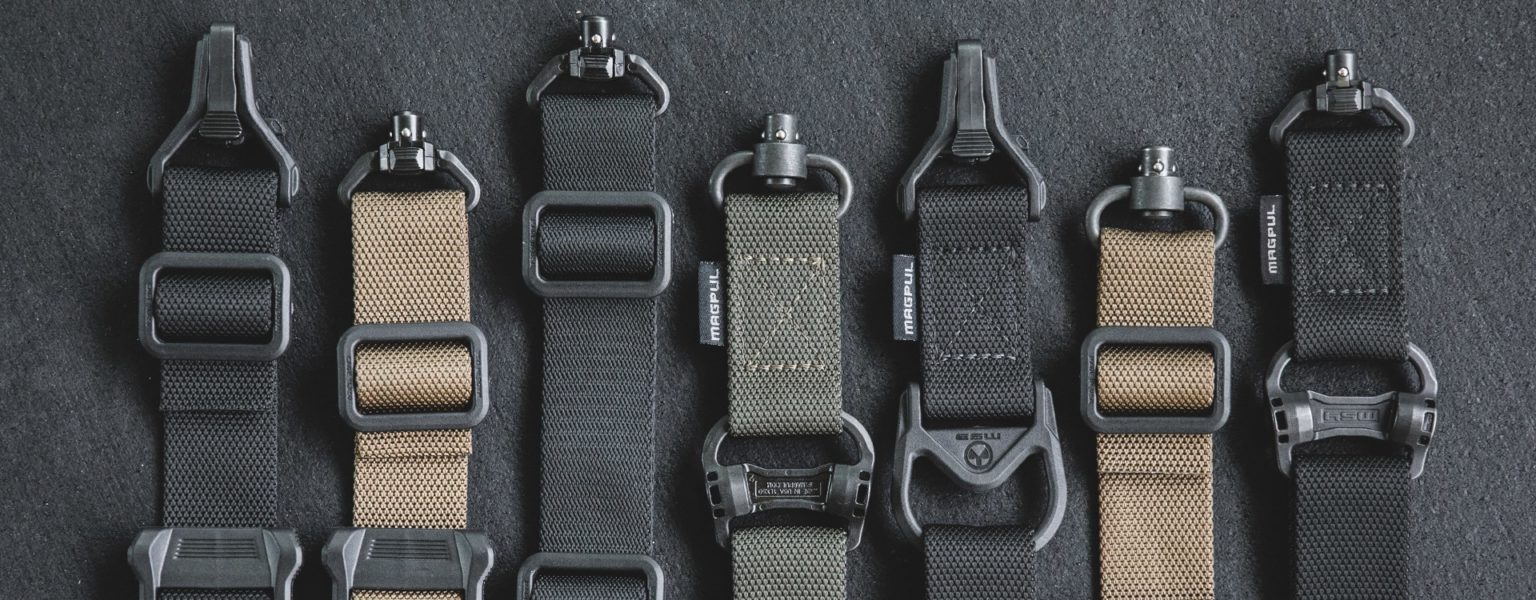
Folks call these things studs, swivels, QD mounts, attachments, and hooks. They're all the same thing: Sling mounts. Sling mounts are either fixed or swivel. They install as a fixed (permanent or requiring tools to remove) or quick-detach mount.
Fixed vs. Swivel Mounts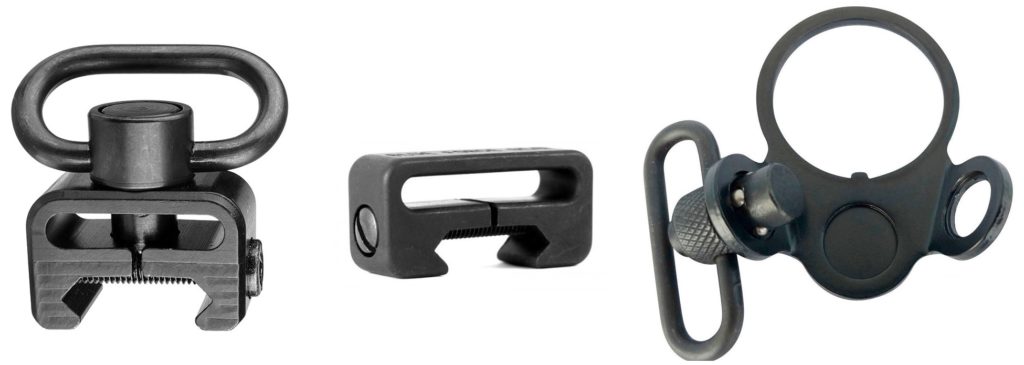
Standard vs. Quick-Detach (QD) Mounts

Quick-detach mounts typically use a small button and four ball bearings to connect and disconnect. This uses the same principle as as sockets and a ratchet wrench. Standard sling mounts will typically use pins or direct-to-rail fasteners made for the rail type (Picatinny, M-Lok, or Keymod).
HK Snap Hook
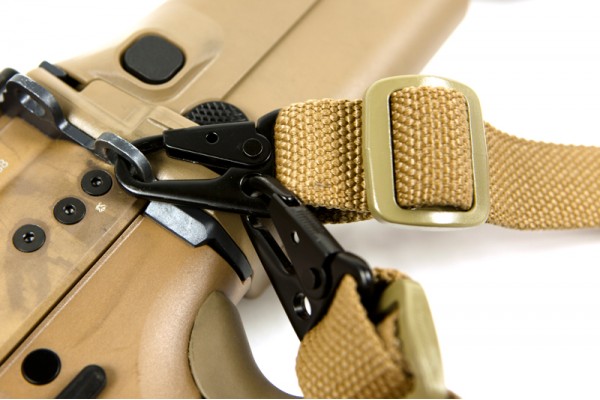
The most universal sling mount (some argue it's the best) is the HK Snap Hook. It'll snap onto any loop or fastener that's wide enough. It works like a carabiner, with a spring-loaded snap guard that prevents the hook from coming loose. The hook can be used on anything from an AR's FSB to a buttstock, most types of sling mounts, and most latch plates. It offers swivel movement and works with any nylon sling. The HK hook is this writer's sling mount of choice.
Sling Materials
Sling material matters just as much as the number of attachments and the sling's design. Some materials have stretch while others are semi-rigid. Each material provides advantages and disadvantages.
Ballistic Nylon

Nylon is the most common material you'll find on a modern sling, especially if it's made for an AR-15. Nylon is a favorite because it has zero stretch or give. If you're trying to size up your sling just right for rock-solid support while shooting, nylon is a great choice. Because it's a thin and cloth-like material, nylon provides the most pliable and lightest sling. It's one of the strongest materials and it's affordable. A small strip of nylon is capable of holding hundreds of pounds without fraying or tearing. Because of its strength and tight weave, a nylon sling makes a great back-up tourniquet.
Leather

Leather is the original material used for making rifle slings. Leather provides the most padding and surface area, and it's favored among shooters handling larger calibers. Although typically not as finely adjustable as nylon, leather slings provide the most support when shooting. You'll find leather slings on AR-type rifles but they're mostly used on bolt guns, bench rifles, and for hunting.
Neoprene
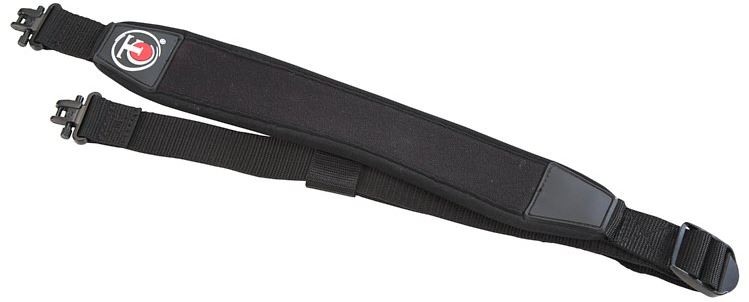
Neoprene is never used as the only material in a sling. You'll find this material used in leather and nylon to provide added padding, comfort, and stretch. Neoprene's elasticity can help add tension and stability to a sling hold while shooting and it does a great job of damping your rifle while walking and traveling.
Braided Paracord
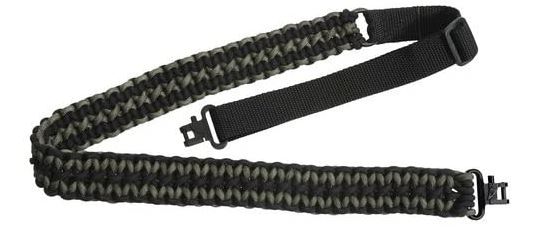
Paracord has made its way into the sling world, made popular in recent years by its entrance to the prepper and survivalism community. Paracord is normally used as the rigging and lines for U.S Military airborne units' parachutes. This braided fabric is one of the strongest types of nylon. A single strand is capable of holding up to 1,000 pounds of static weight. These braided slings are favorites among woodsmen and preppers because when unraveled, they provide a few hundred feet of Paracord. This can be incredibly useful in an emergency for fastening traps, fishing, storing food, and creating an improvised shelter.
Types of Slings & Holds
The type of sling you pick will determine how you carry your rifle and how you create sling holds for improving sight picture and shot placement. There are five widely used types of rifle slings.
Single-Point Sling
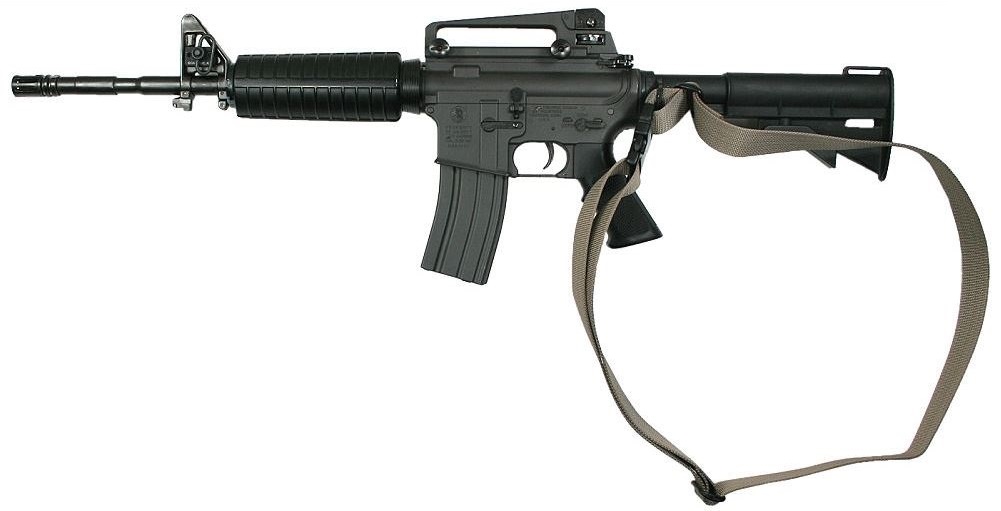
The single-point sling is the simplest of the bunch. It's the most universal and works with practically any rifle, SBR, or pistol and it sizes up for any shooter, large or small, without issue. It's the most affordable thanks to its design. This sling loops over the shoulder of your shooting arm, and under the armpit of the supporting arm.
Pros
Since it attaches at just one point on the rifle, usually near the buffer tube housing, the single-point sling isn't affected by the length of your AR's adjustable buttstock. Sized up correctly, this sling keeps your rifle hanging right by your shooting shoulder so it's easy to go from hands free to the high-ready in a hurry. It doesn't attach near the handguard or muzzle, so it can't get tangled up or caught on any accessories, like a bipod or tactical light. The single-point sling is the easiest to use and offers the most freedom of movement, making it a favorite among AR owners.
Cons
The single-point sling can't act like a good shooting aid. It won't improve stability and it doesn't do much for helping accuracy. If you don't have a hand holding your rifle, the single-point sling will allow your rifle to move freely. That can get annoying or painful.
Two-Point Sling
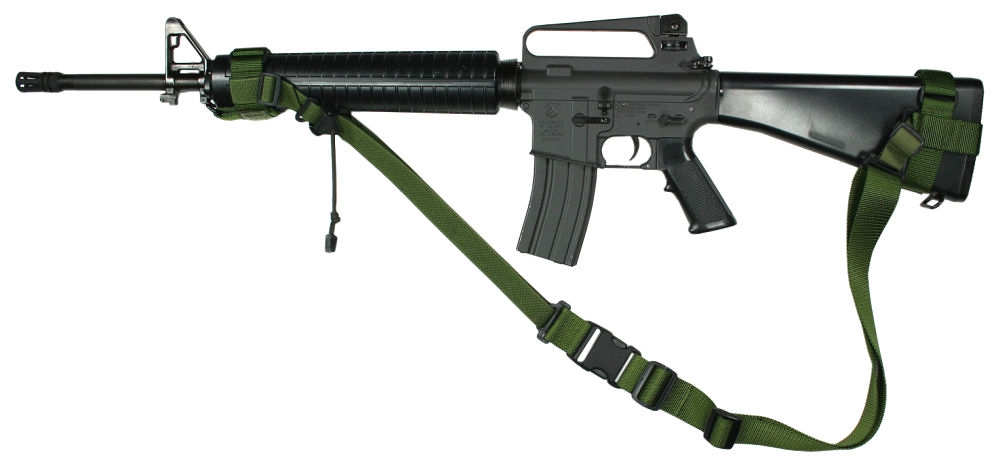
The two-point sling is the original rifle sling first used by the world's first marksmen. The 2-point sling provides various easy methods for carrying your rifle. It's also the most versatile when used as a shooting aid.
Two-point sling carry styles
American Carry
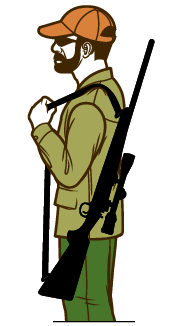
The American Carry's been made famous by so many wartime films. This carry requires slinging the rifle behind the nonfiring shoulder, with the muzzle up.
- Pros: The American Carry is the most comfortable. It keeps the rifle secure and is convenient for long-distance travel on foot, and the non-firing hand can act as a lazy anchor without tiring.
- Cons: The American Carry provides the slowest response time when transitioning to a firing position. It isn't ideal for tactical situations.
European Carry
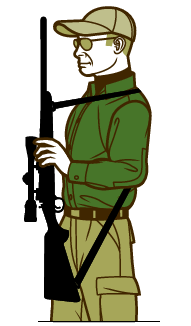
Slung over the front of the shoulder with the muzzle up, the European Carry is an "old-school tactical" carry. This method uses the sling to create tension and stability between the rifle and shooter.
- Pros: It allows for a relatively quick transition to the high-ready shooting position and the shooter maintains better positive control of the rifle.
- Cons: The European Carry is the least comfortable and requires more engagement from the non-firing hand. This carry can also be awkward for semiautomatic rifles with box magazines, since the bottom of the receiver faces the shooter.
African Carry
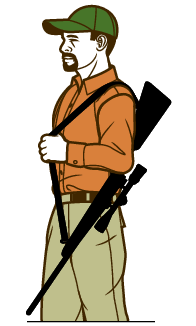
With the rifle slung over the back of the shoulder, muzzle down, the African Carry is designed to provide the quickest transition into a shooting stance from a carrying position.
- Pros: The African Carry is the best tactical carry method with a two-point sling. It a quick, intuitive, and easily repeatable transition from the shoulder to the high-reading shooting position.
- Cons: This method requires carrying the rifle with the muzzle facing the dirt. This could cause your muzzle to clog if you're not aware of it while crouching or kneeling.
Improvised Hasty Sling
Also called the USGI Sling or Loop Sling, the Hasty Sling is made by detaching the rearward point of the sling from the rifle's buttstock and loosening the length-adjusting buckle to fit the supporting arm through. The Hasty Sling is demonstrated below:
This provides tension against the muzzle end of the rifle, improving stability and shot placement when standing or crouched.
Three-Point Sling
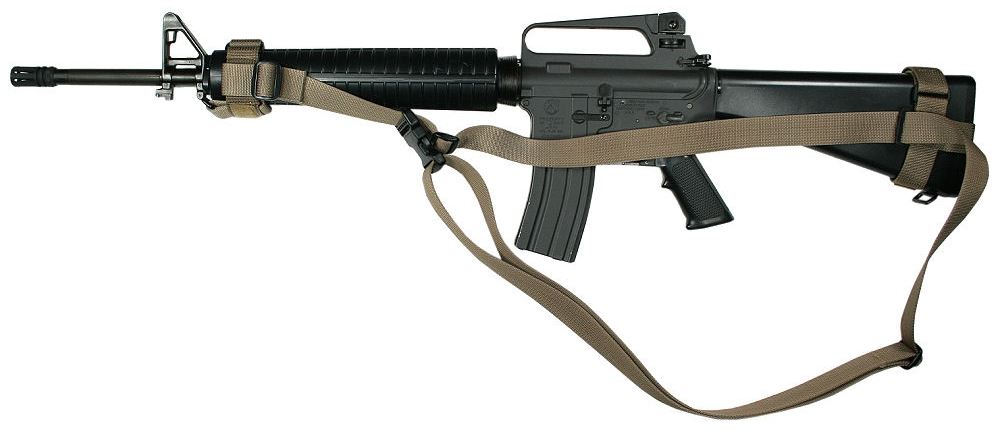
The Specter Gear M-16 / AR-15 QBC 3-Point Sling
The three-point sling is the latest sling to hit the market. It was designed exclusively for shorter carbines and tactical rifles like the AR-15. This sling is meant to facilitate a quick transition to the high-ready from a low-ready or patrol carry. It also provides better comfort than a single- and two-point sling. Lastly, it offers different carry methods with one or no hand on the rifle.
Three-point sling carry styles
The three-point sling provides various carry methods include the off-side drop, military patrol, port arms, rear sweep, climbers' carry, the hasty carry, and many others.
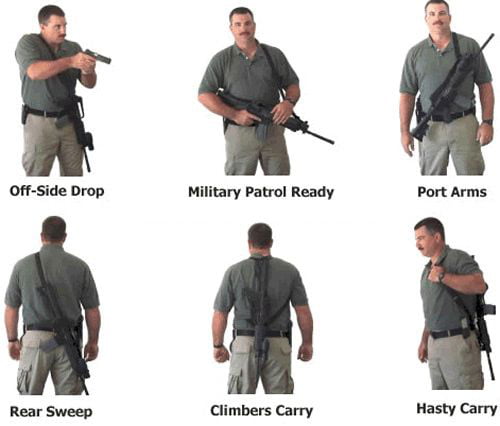
By providing so many carry methods, the three-point sling works for military and security personnel who may be tasked with different operations that require carrying one's rifle a particular way. The three-point sling works with plate carriers, various rifle accessories and attachments, and it provides stability when the rifle is slung hands-free.
Other Sling Types
The Ching Sling

The Ching Sling, developed by professional shooter Eric Ching, is a three-point sling that allows the supporting hand and arm to provide extra tension on the rifle, reducing weapon sway and movement from recoil. This sling maintains three points of contact with the rifle, but the purpose of the third contact point is not to position the rifle a certain way when slung. The third contact point creates a cradle for the arm, acting as a point of tension when firing from a standing or crouched position. Firearm historian Ian McCollum from Forgotten Weapons provides an excellent summary of the Ching Sling's function using this Steyr Scout.
The Rhodesian Sling

The Cuff Sling

The Jensen's 40mm Cuff ISU Rifle Sling
The Cuff Sling provides a hanging adjustable loop for the supporting arm. Like the Ching and Rhodesian, the Cuff provides stability when shooting from a standing or crouched position by enabling the supporting arm to create tension against the rifle. The difference here is the Cuff's design: Rather than use three points of contact on the rifle, the Cuff Sling provides a simple loop built into a two-point sling.
Best Single-Point AR-15 Slings
S2Delta Single-Attachment Sling
An affordable, simple 2-for-1 sling.
Okay, so the S2Delta could
technically be called a 2-point sling. And, if you want to use it as a proper two-point sling, you can. But configured as a single-point sling, it's one of the best available. The nylon strap connects to just about any brace or buttstock, while a clip provides quick-detach function without having to take the sling off:
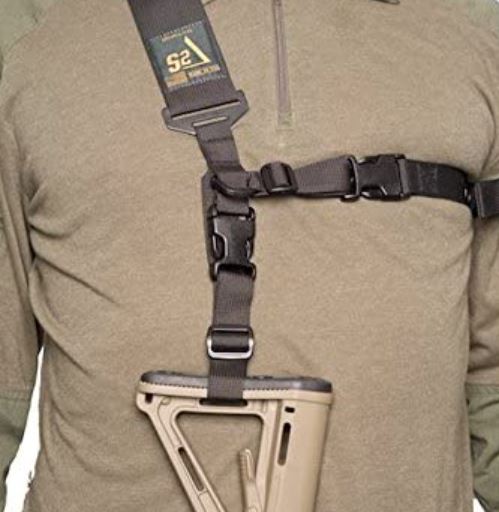
With this setup, your rifle hangs directly at the center of your chest and it provides a quick and easy transition to the high-ready position without the sling itself getting in the way. A wide shoulder strap keeps the weight of your rifle distributed across your shooting side, and the straps are adjustable for height and chest width. If you prefer it, the open ends of the S2Delta allow for easy attachment of any QD studs or snap hooks.
Specifications
- Weight: 6.0 oz
- Max Length: More than you need
- Width: 1.00" nylon and 2.00" shoulder strap
- Attachment: Pig tail (open nylon), Snap Hook, QD
Pros
Any shooter buying into a single-point sling wants it to do one thing: Keep his or her carbine or black rifle hanging inches from the hands and shooting shoulder. The S2Delta's simple nylon design (with plenty of length to spare), adjustable straps, and quick-detach clip provide just that.
- Functions as a single- or two-point sling
- Accepts virtually all attachment studs and clips
Cons
Some say the S2Delta's straps are way too long. But there's a stupid-simple answer to this: Cut them. Seriously. Nothing is stopping you. The sling's incredibly light and simple, but it lacks padding. the width of the shoulder strap seems to mitigate the lack of padding, though.
- No padding on the shoulder strap for heavier rifles
- Excess strap length (if you're lazy or don't own scissors)
UTG Single-Point Bungee Sling w/ QD Latch Plate
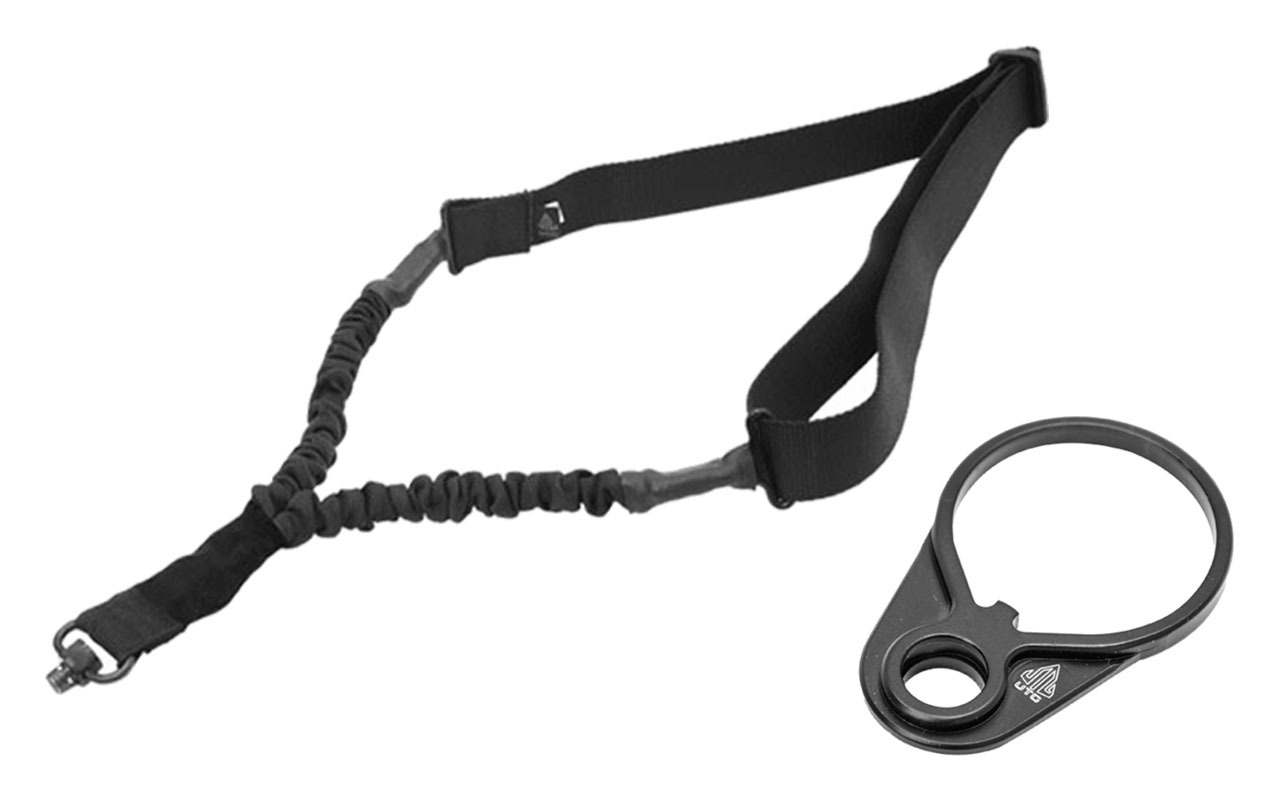
A great load-damping sling with a free latch plate.
UTG's been making no-frills AR parts and tactical gear for quite awhile. So it's not surprising they released an excellent, easy-to-use sling that's affordable. The Bungee Single-Point is quite comfortable, especially on the move. This writer installed this sling on his 300 BLK pistol and found the bungee works quite well for damping all the bouncin' and bangin' your rifle might endure if you're runnin' and gunnin'.
Check out the UTG Bungee Sling here.
Specifications
- Weight: 8.0 oz
- Max Length: 58"
- Width: 1.5"
- Attachment: Steel QD stud
Pros
The UTG provides an excellent hang for your AR and the bungee is helpful for reducing those painful muzzle taps to the groin and knees. The wide shoulder strap is comfortable and tough. Stitching is solid all around. The QD stud's knurled with strong springs. The latch plate is a nice touch, too: Installing the sling just behind the pistol grip provides a perfect center-of-gravity hang for your AR. Getting to the high-ready position is super easy.
- Very tough, reinforced fabric and stitching
- QD stud is high-quality and provides a positive lock
- Easy to maneuver at the low- or high-ready on the move
Cons
Some might not like the stretch and elasticity of this sling. Since ballistic nylon has no give, the straps covering the neoprene had to be given plenty of slack. The extra nylon might look "frumpy" to you. This shouldn't bother most AR guys and operators, but some Gucci rifle owners might not appreciate the aesthetic. We don't judge.
Tactical Single Element Carry Strap Sling
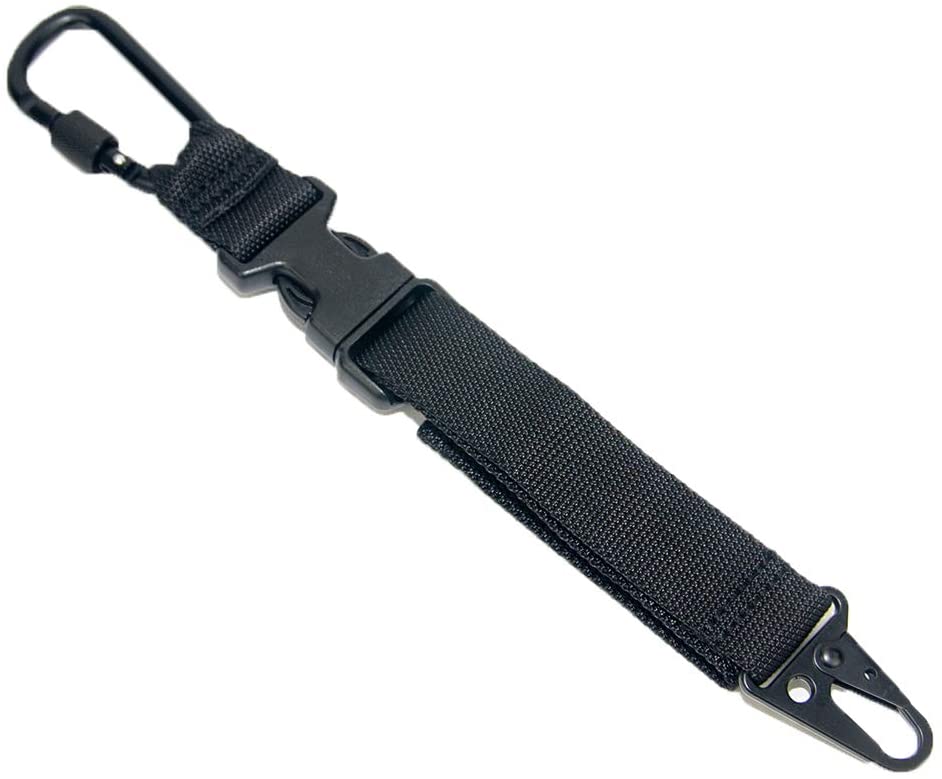
It barely qualifies as a sling. That might be a good thing.
Specifications
- Weight: 3.2 oz
- Max Length: 16"
- Width: 1.25"
- Attachment: Carabiner, HK Hook
Pros
If you want little more than some nylon and two hooks or studs to attach your AR to whatever's on your chest or shoulder, this is it. No extra straps or flaps, no major adjustments, no bits and pieces to snag on anything around you. It really is barely a sling, and that's why it's so nice.
- Quick-release buckle detachment
- Multiple attachment methods provided w/ carabiner
- The shortest and most minimal rifle sling available
- Simple and easy-to-use design at a low price
Cons
You'll need some sort of equipment - whether that's a pack, shoulder system, plate carrier, or other gear - to attach one end of this thing to your person. Of course, you could throw it onto some other sling and improvise your own design if you wanted to, well, sling this over your shoulder. That might defeat the purpose.
Amart 2-Point Sling w/ Adjustable Length
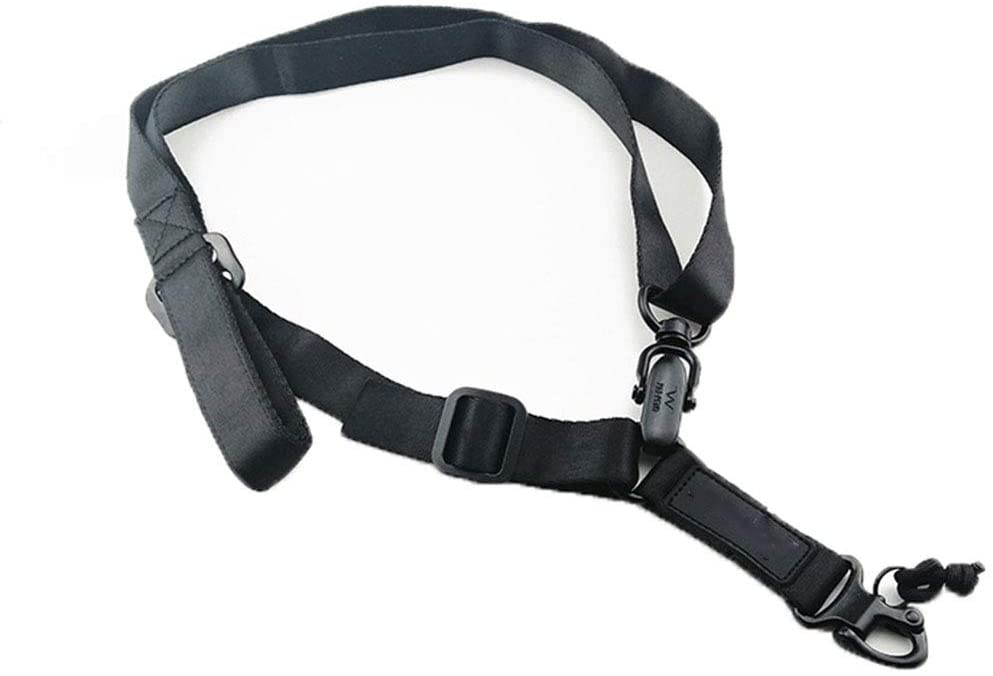
The cheapest 2- and single-point sling with all-metal fixtures.
Amart's a little-known brand, but they've put together a surprisingly nice 2-point sling that acts like a single-pointer, much like the S2Delta. If you don't want a quick-detach clip, and instead prefer something that maintains a solid connection to the rifle via locking studs or hooks, well, that's where the Amart Sling is different. It has no quick-detach clip like the S2Delta, but it does come with some nice metal swivels for both the AR attachment and the claps that wraps around your chest.
Check out Amart's 2-Point / Single-Point Sling.
Specifications
- Width: 1.25"
- Max Length: 53"
- Attachment: Locking Hook
Pros
There's no plastic to speak of on the Amart Sling. Again, if you don't like the S2Delta's plastic clip, this is a nice bonus. We're pleasantry surprised at all the metal swivels built into this super cheap ($12 or so) sling. The firearm attachment is a proprietary locking lobster-style hook that should fit most generic looped sling mounts. There's even a pull pin to remove this hook and replace it with your own HK hook or QD stud.
- Simple but tough 1.25" nylon construction
- Swivel is built into chest strap for a flat fit
- All metal hardware, no plastic anywhere
- Our most affordable pick at around $12
Cons
Unlike the S2Delta, the Amart doesnt provide an adjustable section for the final length of nylon that attaches directly to the sling mount and your AR or other rifle, but this provides no major issue for fitment: Both the vertical and chest strap sections are adjustable to get the right final length.
Best Two-Point AR Slings
Magpul MS1 Sling
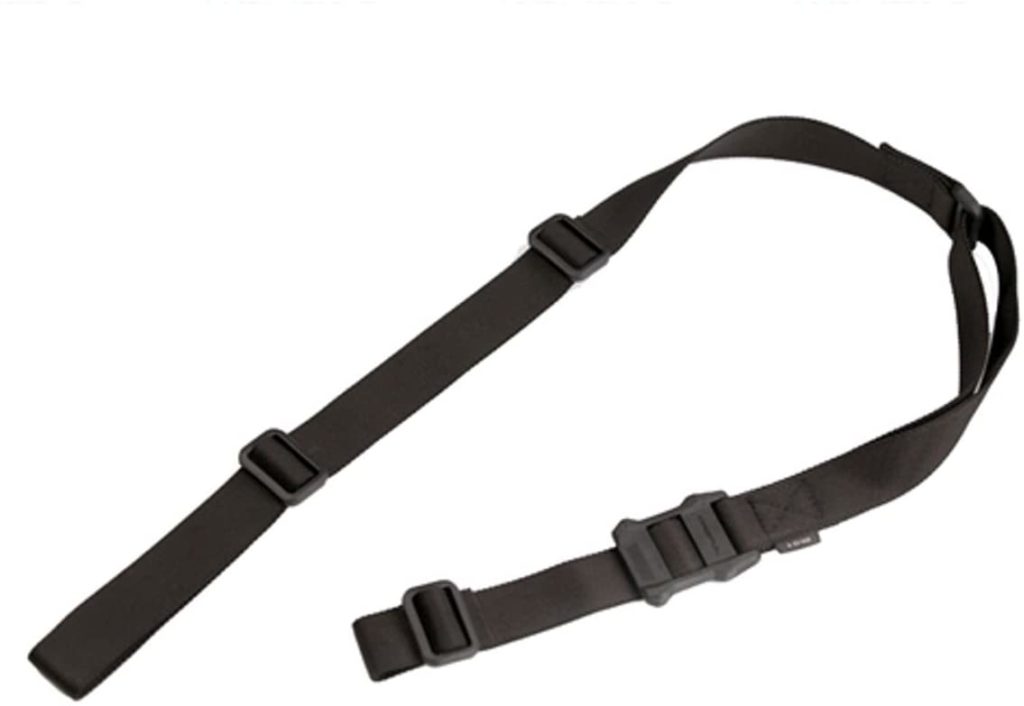
Most affordable "good" 2-pointer.
Low-brow English up there, but it's true: Magpul's MS1 is a great two-point sling. It's the most affordable one that, in this writer's opinion, won't fall apart in a year or snap a buckle because it sees real use. Advertised by most as simply the Magpul Two-Point, this USGI-style sling provides everything a nylon sling should offer. Nothing more, nothing less. At 1.25" it's just wide enough and will fit any buttstock's sling mount or your favorite high-speed QD or swivel mount. The quick-adjust can be easily worked with one hand, but it has plenty of bite and ain't moving unless you want it to. All the tri-glides hold in place when snagged or yanked, yet move freely when needed. Two extra tri-glides on the rearward portion of the sling are perfect for fastening a cuff or hasty sling without detachment.
Specifications
- Weight: 6.0 oz
- Max Length: 60"
- Width: 1.25"
Pros
The MS1 Sling is utterly reliable. This writer used this sling daily for a few years, and keeps one on a 300 BLK pistol build. Adjusting it constantly to stand, crouch, and lay prone, and having it drag all over my plates and magazines never caused the sling to fray or the buckle to break. Are there less expensive two-point nylon slings? Of course. But they won't guarantee that type of American-made reliability you want in a firearm component. This is as affordable and reliable as it gets.
- Manufactured in the USA
- Low price point ($50-$60)
- Strong, sleek, minimalist
- Built-in "hasty" sling
- USGI style is easy to use
- Compatible with QD/Swivels
Cons
The only drawback to a design as basic as the wheel being round is that this sling is good at one thing only: Being a two-point sling. You don't get anything special or "tacticool" out of it but. The lack of padding could also get annoying if you're rucking with your rifle or doing a foot patrol and you're not wearing plates or a vest. FYI, some sort of "pad width" is mentioned on the product page, but this sling is not padded. Nonetheless, if you're shopping at sub-$100 prices and looking at two-point slings, you're probably not looking for extra and the cost savings and simplicity might make sense for you.
- Basic design lacks padding
- Swivels and mounts cost extra
Blue Force Gear Vickers Combat Application Sling (VCAS)

The best padded two-pointer.
Blue Force Gear's Padded Vickers Combat Applications Sling (VCAS) is an honorable mention and ties as a favorite for the two-point category. It runs around $25 more than Magpul's MS1, but you're certainly getting more bang: With a wider, thicker tubular strap with plenty of padding, the Vickers gives extra comfort and can make a noticeable difference in the "sling-digging-into-your-tired-shoulders" department.
Grab the Vickers Padded Sling here.
Specifications
- Weight: 5.0 oz
- Max Length: 67"
- Width, Sling: 1.25"
- Width, Padding: 2.00"
Pros
The Vickers provides a few bells and whistles missing from the MS1. Its biggest feature for tactical rifle owners is the patented pull tab adjuster. It's a single-hand length adjustment that works well in a pinch. The wide tubular nylon is filled with cushion to make the padding as comfortable as possible. Blue Force Gear advertises using a special type of DuPont nylon to get some extra strength and wear out of the Vickers, too. Available with anodized aluminum fasteners and hardware, the Vickers Padded Sling is a beefier and more comfortable version of the MS1.
- Also manufactured in the USA
- Sub-$100 (~$70) with plenty of features
- Available in Black, Multicam and Coyote Brown
- Optional aluminum fasteners available
- Wide cushioned padding for comfort
- Made of DuPont Zytel ballistic nylon
- Pull tab for one-hand adjustments
Cons
Like the MS1, the VCAS doesn't provide anything more than what you see. It's a simple design that doesn't leave much in the way of innovation or special features. The extra padding and various adjustment buckles might feel bulky to shooters who prefer a minimalist strap like the MS1.
- Padding and buckles adds some bulk
VTAC Quick Adjust Wide Upgraded Sling
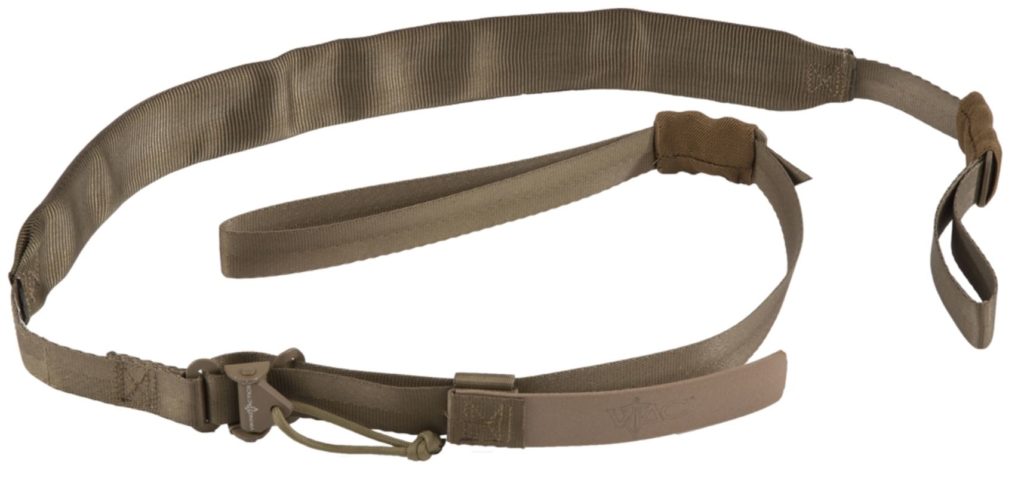
The toughest and easiest-to-just two-point sling.
Viking Tactic's upgraded Wide Sling is arguably the best AR-15 sling in the two-point category. This is a high-quality sling that can be (and is by many) trusted in a combat environment.
The Quick-Adjust VTAC can be grabbed here.
Specifications
- Weight: 8.0 oz
- Max Length: More than you need (cut it)
- Width, Sling: 1.00"
- Width, Padding: 2.00"
Pros
This sling is indestructible, based on personal experience. Its rolled nylon padding is about as tough as the tie-downs on a big rig, yet it's still somehow incredibly comfortable and smooth to the touch. All the VTAC sling's stitching is thick and reinforced, and the quick-adjustment pull tab with its big rubber handle is lightning-quick yet steadfast. If you're the shooter who absolutely needs a sling with one-handed adjustments in both directions that will work every single time, this is the one. It would be very easy to make an improvised tourniquet with this sling. All hardware is metal. No plastic anywhere. The nylon's treated with resin to prevent fraying and tearing. This is one of the toughest slings on the list. Available in black, coyote, and some fancy Highlander snakeskin-lookin' camouflage.
- One of the most affordable (~$60)
- One of the strongest slings listed
- Comfortable rolled nylon padding
- Most easily adjustable two-pointer
- All metal hardware, no plastic
- Oversized pull tab
Cons
There are no cons that accompany the upgraded VTAC Wide Sling. It has been redesigned and tested repeatedly by service personnel and law enforcement. Short shooters say the sling requires taking up a lot of slack, but the adjustment portion of the nylon strap can be cut down to remove all that extra material. An easy fix for a sling guaranteed to fit anyone short or tall. This writer is 5'9" and cut about 12" off the strap once he had it sized with gear.
Best Three-Point AR Slings
Specter (M-4/AR-15) CST 3-Point Sling
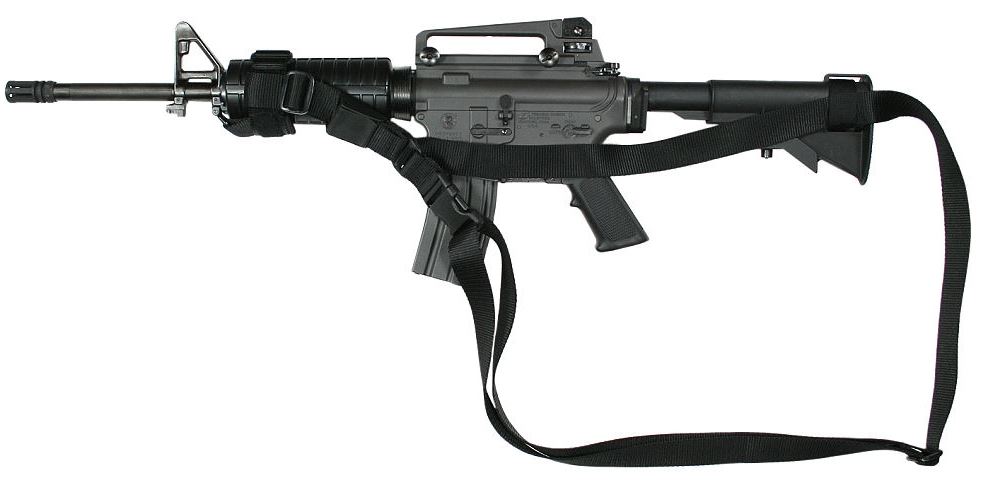 Best adjustable 3-point sling.
Best adjustable 3-point sling.
There aren't many 3-point slings available from big makers, but thankfully, Specter gets it right with their CST 3-pointer. This sling provides adjustment for both the shooter's strap and the muzzle contact point. This lets you cinch up or down your rifle for a patrol carry, a high-and-tight chest tuck, or a vertical drop or climbers' carry.
Specifications
- Width: 1.25"
- Attachment: Hook-and-loop straps
Pros
The CST Sling capitalizes on why the 3-point design works by giving adjustment to get your rifle just right. Three-point slings can get bulky and clingy with all their buckles and straps, but Specter keeps things in check by providing only tri-glides you really need. That is, one for the back strap and one for the rifle strap. Since the Specter uses hook-and-loop fasteners instead of QD or swivel studs, it can be made into an improvised single-point sling. These straps also help to prevent your rifle from swaying and swinging when not held. The Specter's also very affordable at around the $40 price point.
- Available with or without a side-release buckle
- Simple design incorporates just two adjustments
- Ambidextrous thanks to hook-and-loop fasteners
- Sized specifically for AR-15, M4 and carbines
- Front length adjustment is one-hand-pull/push
- Available in black, OD, Coyote, Foliage Green
Cons
The CST isn't set up to accept metal attachments or other mounts, straps only. While this guarantees ambidextrous and "universal" fitment for most rifles, some shooters might find the straps and wrap-arounds on the buttstock and handguard clunky or sloppy.
Magpul MS4 Dual QD Sling GEN2
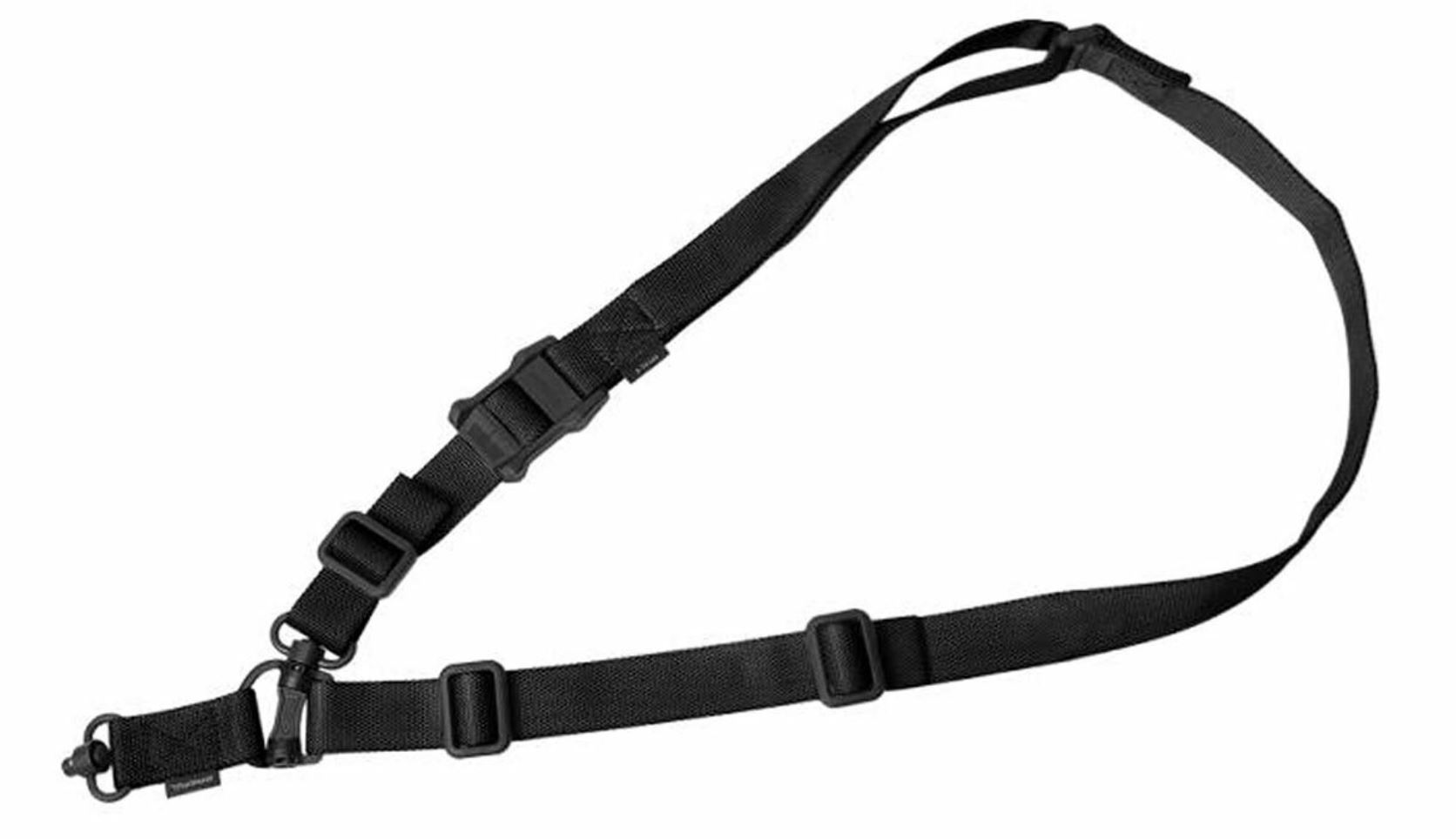
One of the only slings that works as a 1-, 2-, and 3-point setup.
Magpul took some time developing the MS4 and it shows: Double quick-detach points, multiple adjustment buckles, enough nylon for virtually any of the three sling setups, and proper knurled QD studs for use with any latch plate, handguard, or other QD attachment on your AR.
Specifications
- Width: 1.25"
- Attachment: QD Studs
Pros
Great build quality is one of the MS4's strong suites, but its ability to function in any configuration is it's unique advantage. We also like the QD stud that attaches one of the end of the MS4 to its main stud and strap. This allows for easily transitioning between configurations and it makes for easy threading through a rear sling mount or buttstock sling adapter (like the one below). Since it's a swivel, it also prevents the sling from getting bound and twisted up.
Cons
None to speak of. Really. The MS4 is basically a perfect sling and it doesn't cost an arm and a leg. You could argue it doesn't have the extra pad and comfort of some other setups (like the VTAC) but we prefer form and extra function over fluff and comfort.
Depring Tactical Sling Adapter w/ D-Ring
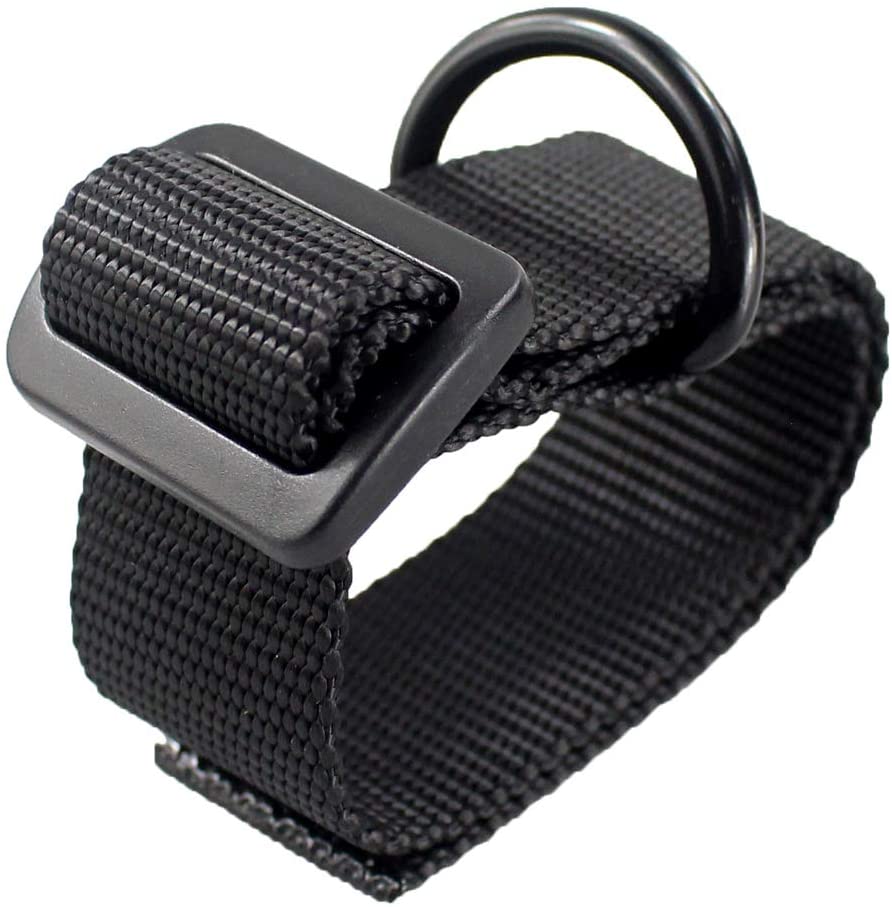
Turn any single-point sling into a 3-point sling.
You really will be hard-pressed to find a decent 3-point sling these days. So, why not just convert a simple single-point into one? That's what the Sling Adapter does. Slap it on your buttstock and thread one half of your sling through the D-ring. Set up your sling's stud or hook to attach at the handguard, and voila: 3-point sling.
Check out the Tactical Sling Adapter here.
Specifications
- Max Length: 16"
- Width: 1.25"
- Attachment: Buckle and D-ring
Pros
The Sling Adapter's a great alternative to shelling out too much cash for another sling, especially if you're happy with your existing setup. It's easy to install, it can be removed in a few minutes, and it's a universal design that'll work with just about any sling you own.
Cons
The Sling Adapter doesn't necessarily have any cons, save for the sling you'll use it with: Your sling needs to be long enough to accommodate a 3-point setup. If the strap's too wide, the D-ring won't work well and you'll need to invest in a wider one yourself.
Best Ching, Loop, & Rhodesian Slings
The Wilderness Ching Sling
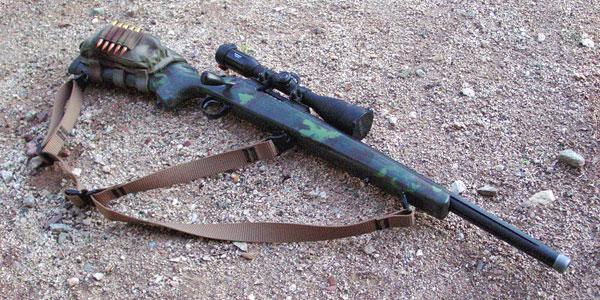
It's the "official" one.
Wilderness Tactical Products, LLC is the only maker licensed to produce Eric Ching's design. They ditched the leather most often used for the Ching Sling and used ballistic nylon to better suit the typical tactical rifle. Permanently-sewn GrovTec locking swivels provide three points of contact for your rifle and justify this sling's $60 price point.
Grab The Wilderness Ching Sling here.
Pros
The Wilderness's Ching Sling is exactly what you want: Highly adjustable and low-profile. Thanks to the use of nylon with tri-glides over leather and buckles, this iteration of the Ching is well suited for your AR and provides better on-the-fly positioning. The GrovTec swivels are knurled and made from steel with nice bluing. Available in black, Coyote Brown, and Foliage Green.
Cons
This sling's permanently installed swivels might not bode well for AR owners who like customization and might want to swap out for different studs or straps.
The Wilderness Langlois Rhodesian Sling
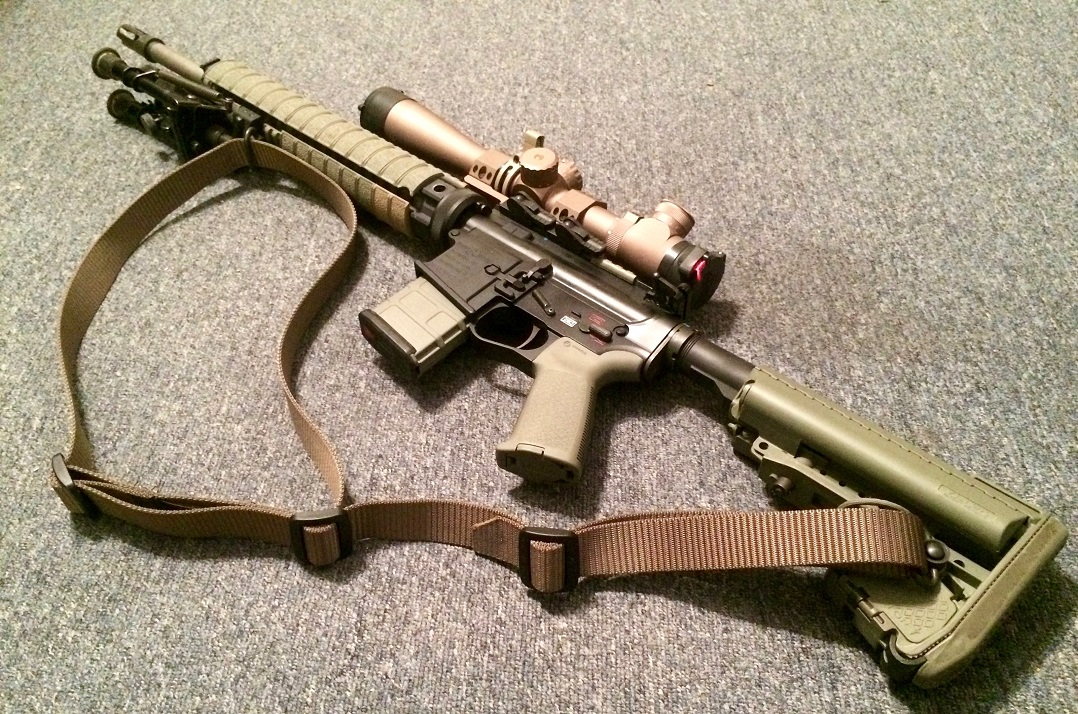
A genius take on the 2-point sling.
Don't like that middle stud on the Ching? Grab the Rhodesian instead. Also made by The Wilderness, this sling is nothing more than a two-pointer with the third tri-glide necessary for cradling the offhand arm.
Grab the Rhodesian Sling here.
Pros
This thing works beautifully . Delrin buckles and quality nylon ensure this sling rides and adjusts as needed and without binding or fuss. It measures 1.25" and works with virtually all swivels and fasteners. Speaking of, you can stick with simple straps or grab optional swivels from GrovTec.
Cons
It's tough to complain about a sling as simple and useful as this one. The Rhodesian's tri-glide buckles are made from plastic instead of metal, and they're a tad thicker than they could be. That middle buckle could get annoying when you're using the sling to cradle the rifle with your supporting arm.
Tactical Intervention Specialists Cuff Sling

Designed by a proper operator, 'nuff said.
The product photo might not say much, other than "Clearly this sling was proven to work." Shown held by CWO2 Kent Gooch, a retired USMC recon sniper, the Tactical Intervention Specialists Cuff Sling is a battlefield-designed take on this archaic military shooting aid. Two models are available. Model 1 is made for longer barrels and bolt guns, and comes with quick-detach swivels. Model 2 provides a shorter strap for carbines and AR-15s and does not come with QD swivels. This is the model we recommend.
Check out the TIS Cuff Sling here.
Pros
This rendition of the cuff sling combines little details to set itself apart. A Fastex buckle is provided instead of a typical tri-glide or snap buckle to reduce pinching on the bicep when the cuff is tight. This also allows the cuff to be adjusted and worn by the shooter on his arm supporting arm when not in use. All that's required to use the cuff quickly is to connect it to the sling via the buckle. The placement of the buckle and cuff allows for a quick one-handed connection. It also forces the cuff to ride high on the arm, eliminating any arterial pulsing through the arm and hand which might affect weapon sway at distance. Smart thinking for an accessory that's deceptively simple, yet which can make a big impact on accuracy at long range.
Cons
None to speak of, perhaps besides its dedication to utility over comfort. This sling is made as a shooting aid first, and a carry strap second. No padding, but that's intentional. The man who designed this sling is one helluva sniper, and he wrote an interesting review that covers this sling's military history, use, and design.
Wrap-Up & Recap
That covers our detailed breakdown and review of how to sling your AR-15 the right way. We hope these recommendations not only help you find a comfortable to carry your rifle, but help you find a more stable shooting position so you can widen your marksmanship tool set and skills.
To recap:
- Sling mounts are either standard or quick-detach
- Sling mounts are available as swivel or fixed
- Nylon tends to work the best for AR slings
- Neoprene provides padding and some stretch
- Single-point slings are best for a quick transition
- Two-point slings provide the most utility
- Three-point slings are the most comfortable
DISCLAIMER: If you are new to the world of DIY gun building, you likely have a lot of questions and rightfully so. It’s an area that has a lot of questions that, without the correct answers, could have some serious implications. At GunBuilders.com, we are by no means providing this content on our website to serve as legal advice or legal counsel. We encourage each and every builder to perform their own research around their respective State laws as well as educating themselves on the Federal laws. When performing your own research, please be sure that you are getting your information from a reliable source.

![The Ultimate AR-15 Sling Guide + Top Picks [2023] The Ultimate AR-15 Sling Guide + Top Picks [2023]](https://cdn11.bigcommerce.com/s-z44cuhyv4y/images/stencil/460x250/uploaded_images/the-ulimate-ar-15-sling-guide-and-top-sling-picks-2021.jpg?t=1626717428)
